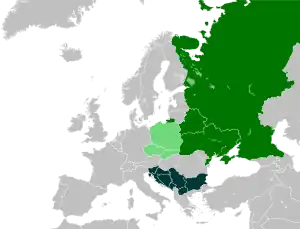Усходнія славяне / Uschodnija słavianie (Belarusian) Восточные славяне / Vostochnyye slavyane (Russian) Восточны славяне / Vostochny slaviane (Rusyn) Східні слов'яни / Skhidni sloviany (Ukrainian) | |
|---|---|
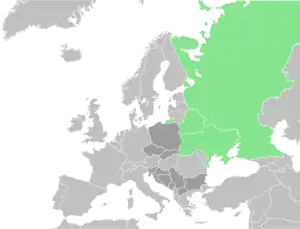 Countries with predominantly East Slavic population | |
| Total population | |
| 200+ million | |
| Regions with significant populations | |
| Majority: Belarus, Russia, Ukraine Minority: Baltics (Estonia, Latvia, Lithuania), Serbia, Caucasus (Azerbaijan, Georgia), Moldova, Turkey, United States, Canada, other former Soviet states. | |
| Languages | |
| East Slavic languages: Belarusian, Russian, Rusyn, Ukrainian | |
| Related ethnic groups | |
| Other Slavs |
The East Slavs are the most populous subgroup of the Slavs.[1] They speak the East Slavic languages,[2] and formed the majority of the population of the medieval state Kievan Rus', which they claim as their cultural ancestor.[3][4] Today, the East Slavs consist of Belarusians, Russians, Rusyns, and Ukrainians.[5]
History
Sources
Researchers know relatively little about the Eastern Slavs prior to approximately 859 AD when the first events recorded in the Primary Chronicle occurred. The Eastern Slavs of these early times apparently lacked a written language. The few known facts come from archaeological digs, foreign travellers' accounts of the Rus' land, and linguistic comparative analyses of Slavic languages.[2]
Very few native Rus' documents dating before the 11th century (none before the 10th century) have survived. The earliest major manuscript with information on Rus' history, the Primary Chronicle, dates from the late 11th and early 12th centuries. It lists twelve Slavic tribal unions which, by the 10th century, had settled in the later territory of the Kievan Rus between the Western Bug, the Dniepr and the Black Sea: the Polans, Drevlyans, Dregovichs, Radimichs, Vyatichs, Krivichs, Slovens, Dulebes (later known as Volhynians and Buzhans), White Croats, Severians, Ulichs, and Tivertsi.[1]
Migration
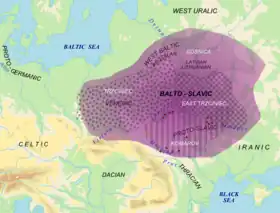
There is no consensus among scholars as to the urheimat of the Slavs. In the first millennium AD, Slavic settlers are likely to have been in contact with other ethnic groups who moved across the East European Plain during the Migration Period. Between the first and ninth centuries, the Sarmatians, Huns, Alans, Avars, Bulgars, and Magyars passed through the Pontic steppe in their westward migrations. Although some of them could have subjugated the region's Slavs, these foreign tribes left little trace in the Slavic lands. The Early Middle Ages also saw Slavic expansion as an agriculturist and beekeeper, hunter, fisher, herder, and trapper people. By the 8th century, the Slavs were the dominant ethnic group on the East European Plain.
By 600 AD, the Slavs had split linguistically into southern, western, and eastern branches. The East Slavs practiced "slash-and-burn" agricultural methods which took advantage of the extensive forests in which they settled. This method of agriculture involved clearing tracts of forest with fire, cultivating it and then moving on after a few years. Slash and burn agriculture requires frequent movement because soil cultivated in this manner only yields good harvests for a few years before exhausting itself, and the reliance on slash and burn agriculture by the East Slavs explains their rapid spread through eastern Europe.[6] The East Slavs flooded Eastern Europe in two streams. One group of tribes settled along the Dnieper river in what is now Ukraine and Belarus to the North; they then spread northward to the northern Volga valley, east of modern-day Moscow and westward to the basins of the northern Dniester and the Southern Buh rivers in present-day Ukraine and southern Ukraine.
Another group of East Slavs moved to the northeast, where they encountered the Varangians of the Rus' Khaganate and established an important regional centre of Novgorod for protection. The same Slavic population also settled the present-day Tver Oblast and the region of Beloozero. Having reached the lands of the Merya near Rostov, they linked up with the Dnieper group of Slavic migrants.
Pre-Kievan period

According to archeology, the Prague, Korchak, Penkova, Kolochin and Kyiv cultures are classified as early Slavic, the earliest of which, Kyiv, from the 2nd–3rd centuries AD. e. was the northern neighbor of the more developed and multi-ethnic Chernyakhov culture, associated with West Slavs (Great Moravia). Rare, few and short-lived settlements of the Slavs were located "in unusual topographic conditions: in low places, often now flooded during floods".[8]
Eastern Slavs, who found themselves as a result of migrations of the 4th–5th centuries. in the basins of lakes Chudskoye and Ilmen, formed the culture of Pskov long barrows. This culture was strongly influenced by the autochthonous Finno-Ugric and Baltic peoples, from whom it adopted a specific burial rite and some features of ceramics, but in general, the way of life of the Eastern Slavs changed little. By the 5th century on the site of the Kyiv culture and in other regions to the north, east, west and south of it, a number of related cultures arise, such as Korchak, Kolochin, etc.[9]
Among the East Slavs, fortified cities, apparently, first appeared among the Ilmen Slovenes in the 5th century (based on archaeological data in the town on Mayat river). The first settlements near the Polans and Severians arose in the region of Kyiv and Chernigov already by the 7th–8th centuries,[10] which indicates at least a partial rejection of the previous strategy of scattered and secretive living among the forests. This is also evidenced by the fact that in the VIII-IX centuries. in all other East Slavic lands there were no more than two dozen cities, while only on the Left Bank of the Dnieper there were about a hundred of them. The foundation of the main Slavic city of this region, Novgorod, is attributed by the letopis to 862.[11] In the same era, settlements appeared on the territories of other East Slavic tribes (see Old Russian cities). So, the northerners who lived on the territory of modern Voronezh, Belgorod and Kursk regions, along with settlements in the 9th–10th centuries. built fortified settlements, mainly at the confluence of large rivers (see Romensko-Borshchiv culture).[12] In the 10th century, a fortress appeared not far from the city of Smolensk that arose later (the Gnezdovsky archaeological complex).
Somewhat apart are the early East Slavic settlements, the creation of which is attributed to the tribal unions of Dulebs and Antes. Archaeologically, they are represented by the Prague-Korchak and Penkov cultures, respectively. A number of such settlements of the Prague-Korchak (Zimino, Lezhnitsa, Khotomel, Babka, Khilchitsy, Tusheml) and Penkovo (Selishte, Pastyrskoe) cultures existed in the 6th–7th centuries. on a vast territory from the borders of modern Poland and Romania to the Dnieper. The Prague-Korchak settlements were a site surrounded by a wooden wall with one building, which was part of the common wall of the settlement. They did not have agricultural tools, and the settlements, apparently, were built to collect and accommodate a military detachment. Penkovsky settlements could have up to two dozen buildings inside the walls and were large trade, craft and administrative centers for their time. The center of the territory controlled by the dulebs (Zimino, Lezhnitsa) was in the basin of the Western Bug; the geographical center of the Penkovo culture falls on the Dnieper region, but the main fortress of the Antes (Selishte) was located in the western part of this area, near the borders of Byzantine Empire (in modern Moldova), on which they made military campaigns.[9] The early Slavic settlements were destroyed by the Avars in the 7th century, after which they were not built until the 10th century.[13]
Kievan period
.jpg.webp)
It is uncertain how the state of Kievan Rus' came to be, but the Varangian nobleman Oleh the Wise is generally credited with having established a principality at the city of Kyiv somewhere around the year 880.[lower-alpha 1] Kyiv had already been established, but its origins are nebulous as well. According to archaeologists and historians such as Petro Tolochko (2007), Slavic settlement existed from the end of the 5th century in the area that later developed into the city.[15] Kyiv may have paid tribute to the Khazars before Oleh conquered it.[16][17] Tolochko and other scholars also theorise that 'Kyiv was not the center of any particular tribe but the intertribal center of a vast realm'; critical analysis of the Primary Chronicle, De Administrando Imperio and other sources suggests it may have been a cosmopolitan urban home to Slavic and non-Slavic groups, such as Scandinavian Varangians and Finno-Ugric peoples.[18] Slavic peoples that were reportedly native to Ukraine included Polans (or Polianians), Drevlyans, Severians, Ulichs, Tiverians, White Croats and Dulebes, but their precise identity and interrelationships are difficult to establish and verify, as the sources are vague, contradictory and at times inaccurate.[19]
In the 10th and 11th century, Kyiv became one of the richest commercial centres of Europe, and the Kievan Rus' empire around it steadily expanded.[20] Initially a benefactor of the worship of Slavic deities such as Perun, Volodimer I converted to Orthodox Christianity in the 980s, tying the realm into a political and ecclesiastical alliance with the Byzantine Empire.[20] The reign of Yaroslav the Wise (r. 1019–1054) is generally regarded its zenith; Kievan Rus' was the most prosperous and powerful empire within Christendom.[20] Kievan Rus' was never a fully centralized state, but rather a loose aggregation of principalities ruled by members of the Rurik dynasty.[21]
Post-Kievan period

The disintegration, or parcelling of the polity of Kievan Rus' in the 11th century resulted in considerable population shifts and a political, social, and economic regrouping. The resultant effect of these forces coalescing was the marked emergence of new peoples.[22] While these processes began long before the fall of Kiev, its fall expedited these gradual developments into a significant linguistic and ethnic differentiation among the Rus' people into Belarusians, Russians, and Ukrainians.[22] All of this was emphasized by the subsequent polities these groups changed to: northwestern and southwestern Rus', where the Ruthenian and later Belarusian and Ukrainian identities developed, was subject to Lithuanian and later Polish influence;[23] whereas the Russian ethnic identity developed around Muscovy under occupation by Golden Horde in the east and the Novgorod Republic in the north.
Modern East Slavs
Modern East Slavic peoples and ethnic/subethnic groups include:
- Belarusians
- Cossacks
- Zaporozhian Cossacks
- Tavria Zaporozhians
- Black Sea Zaporozhians
- Zaporozhian Cossacks
- Podlashuks
- Poleshuks
- Russians
- Rusyns
- Ukrainians
- Cossacks
- Halychans
- Podolyans
- Slobozhanians
- Zaporozhian Cossacks
Population
Genetics
According to Y chromosome, mDNA and autosomal marker CCR5de132, East Slavs and West Slavs are genetically very similar, which is consistent with the proximity of their languages, demonstrating significant differences from the neighboring Finno-Ugric, Turkic and North Caucasian peoples all the way from west to east; such genetic homogeneity is somewhat unusual for genetics given such a wide dispersal of Slavic populations, especially Russians.[24][25] Together they form the basis of the "East European" gene cluster, which also includes Balts, some Balkan peoples[24][26] and the non-Slavic Hungarians and Aromanians.
Only the Northern Russians among the East and West Slavs belong to a different, “Northern European” genetic cluster, along with the Balts, Germanic and Baltic Finnic peoples (Northern Russian populations are very similar to the Balts).[27][28]
Image gallery
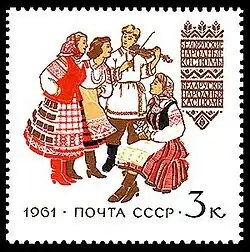 Belarusians in traditional dress
Belarusians in traditional dress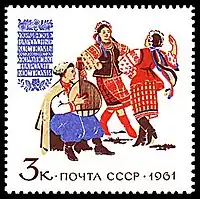 Ukrainians in traditional dress
Ukrainians in traditional dress
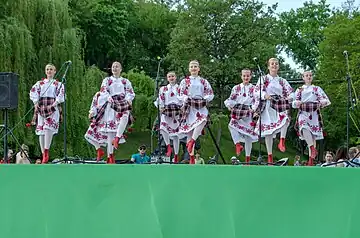 Belarusian dance
Belarusian dance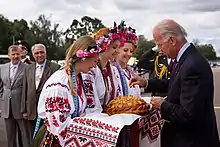 Bread and salt greeting ceremony in Kyiv, Ukraine
Bread and salt greeting ceremony in Kyiv, Ukraine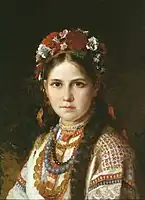 A young Ukrainian girl in a folk costume, by Nikolay Rachkov
A young Ukrainian girl in a folk costume, by Nikolay Rachkov_Commanding_Officer%252C_Capt._Leo_Goff_participates_in_a_welcoming_ceremony_on_the_pier.jpg.webp) Bread and salt greeting ceremony in Vladivostok, Russia
Bread and salt greeting ceremony in Vladivostok, Russia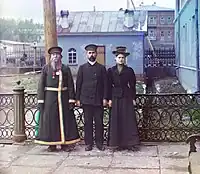 Three generations of a Russian family, c. 1910
Three generations of a Russian family, c. 1910
See also
Notes
- ↑ 'Regardless of the uncertainties surrounding the origin of Rus', with Helgi/Oleh (reigned 878–912) we have a known historical figure credited with building the foundations of a Kievan state. (...) With Oleh's invasion of Kiev and the assassination of Askol'd and Dir in 882, the consolidation of the East Slavic and Finnic tribes under the authority of the Varangian Rus' had begun.'[14]
References
Citations
- 1 2 Ilya Gavritukhin, Vladimir Petrukhin (2015). Yury Osipov (ed.). Slavs. Great Russian Encyclopedia (in 35 vol.) Vol. 30. pp. 388–389. Archived from the original on 2022-08-03. Retrieved 2022-08-22.
- 1 2 Sergey Skorvid (2015). Yury Osipov (ed.). Slavic languages. Great Russian Encyclopedia (in 35 vol.) Vol. 30. pp. 396–397–389. Archived from the original on 2019-09-04. Retrieved 2022-08-22.
- ↑ Plokhy, Serhii (2006). The Origins of the Slavic Nations: Premodern Identities in Russia, Ukraine, and Belarus (PDF). New York City: Cambridge University Press. pp. 10–15. ISBN 978-0-521-86403-9. Retrieved 2010-04-27.
For all the salient differences between these three post-Soviet nations, they have much in common when it comes to their culture and history, which goes back to Kievan Rus', the medieval East Slavic state based in the capital of present-day Ukraine,
- ↑ John Channon & Robert Hudson, Penguin Historical Atlas of Russia (Penguin, 1995), p. 16.
- ↑ "Slav". Encyclopedia Britannica. Retrieved 5 January 2020.
- ↑ Richard Pipes. (1995). Russia Under the Old Regime. New York: Penguin Books. pp. 27–28
- ↑ Oscar Halecki. (1952). Borderlands of Western Civilization. New York: Ronald Press Company. pp. 45–46
- ↑ Schukin, Mikhail B. Birth of the Slavs — 2001.
- 1 2 Седов В. В. (1995). Культура псковских длинных курганов // Славяне в раннем средневековье. Moscow: Научно-производительное благотворительное общество "Фонд археологии". pp. 211–217, 416. ISBN 5-87059-021-3. Archived from the original on 2003-06-11. "Славяне северной зоны Русской равнины". Archived from the original on 2003-06-11. Retrieved 2008-11-01.
- ↑ Gorsky, Andrey A. Political centers of the Eastern Slavs and Kievan Rus: problems of evolution Archived 2008-09-30 at the Wayback Machine // Domestic History. 1993. No. 6. S. 157–162.
- ↑ The tale of bygone years. "Электронная библиотека ИРЛИ РАН > Собрания текстов > Библиотека литературы Древней Руси > Том 1 > Повесть временных лет". Archived from the original on 2015-03-16. Retrieved 2015-11-16.
- ↑ Slavs on the Don (Voronezh State University). "Archived copy". Archived from the original on 2017-04-12. Retrieved 2008-11-01.
{{cite web}}: CS1 maint: archived copy as title (link) - ↑ V. Prokopensko. Military affairs of the Slavs Archived 2009-01-31 at the Wayback Machine (in Russian). "Военное дело славян". Archived from the original on 2009-01-31. Retrieved 2009-01-31.
- ↑ Magocsi 2010, p. 65–66.
- ↑ Tolochko P. P., Ivakin G. Y., Vermenych Y.V. Kyiv. in Encyclopedia of Ukrainian History (Енциклопедія історії України). — Kyiv: Naukova Dumka, 2007. — vol. 4. — P. 201-218.
- ↑ Plokhy 2006, p. 30.
- ↑ Magocsi 2010, p. 59.
- ↑ Plokhy 2006, p. 31–32, 47.
- ↑ Plokhy 2006, p. 30–32, 47, 57.
- 1 2 3 "Kiëv; Rusland §2. Het Rijk van Kiëv". Encarta Encyclopedie Winkler Prins (in Dutch). Microsoft Corporation/Het Spectrum. 2002.
- ↑ Plokhy 2006, p. 13.
- 1 2 Riasanovsky, Nicholas; Steinberg, Mark D. (2005). A History of Russia (7th ed.). New York: Oxford University Press. pp. 61, 87.
- ↑ Magocsi, Paul Robert (2010). A History of Ukraine: A Land and Its Peoples. Toronto: University of Toronto Press. p. 73. ISBN 9781442640856.
- 1 2 Verbenko 2005, pp. 10–18.
- ↑ Balanovsky 2012, p. 13.
- ↑ Balanovsky 2012, p. 23.
- ↑ Balanovsky & Rootsi 2008, pp. 236–250.
- ↑ Balanovsky 2012, p. 26.
Sources
- Balanovsky, Oleg; Rootsi, Siiri; et al. (January 2008). "Two sources of the Russian patrilineal heritage in their Eurasian context". American Journal of Human Genetics. 82 (1): 236–50. doi:10.1016/j.ajhg.2007.09.019. PMC 2253976. PMID 18179905.
- Balanovsky, Oleg P. (2012). Изменчивость генофонда в пространстве и времени: синтез данных о геногеографии митохондриальной ДНК и Y-хромосомы [Variability of the gene pool in space and time: synthesis of data on the genogeography of mitochondrial DNA and Y-chromosome] (PDF) (Dr. habil. in Biology thesis) (in Russian). Moscow: Russian Academy of Medical Sciences.
 This article incorporates text from this source, which is in the public domain. Russia: A Country Study. Federal Research Division.
This article incorporates text from this source, which is in the public domain. Russia: A Country Study. Federal Research Division.- Verbenko, Dmitry A.; et al. (2005). "Variability of the 3'ApoB Minisatellite Locus in Eastern Slavonic Populations". Human Heredity. 60 (1): 10–18. doi:10.1159/000087338. PMID 16103681. S2CID 8926871. Archived (PDF) from the original on 2012-01-20.
- Ilya Gavritukhin, Vladimir Petrukhin (2015). Yury Osipov (ed.). Slavs. Great Russian Encyclopedia (in 35 vol.) Vol. 30. pp. 388–389. Archived from the original on 2022-08-03. Retrieved 2022-08-22.
External links
- Ancient Russia by G. V. Vernadsky (in Russian) in three different versions:
